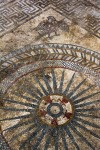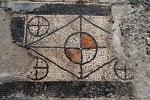 An excavation on the site of a boarding school in Uzès, southern France, has unearthed ancient remains from the 1st century B.C. through the 7th century and beyond into the Middle Ages. The most dramatic discovery is a pair of large mosaic floors of superlative quality from around the 1st century A.D. The aesthetic value of the mosaics would make this a find of international significance in any context, but the historical import compounds its value because these are the first significant archaeological remains discovered from the Roman city of Ucetia. A smattering of mosaic fragments have been unearthed over the years in Uzès, but before now, the existence of the town was documented archaeologically solely by its mention in a geographical inscription in Nîmes.
An excavation on the site of a boarding school in Uzès, southern France, has unearthed ancient remains from the 1st century B.C. through the 7th century and beyond into the Middle Ages. The most dramatic discovery is a pair of large mosaic floors of superlative quality from around the 1st century A.D. The aesthetic value of the mosaics would make this a find of international significance in any context, but the historical import compounds its value because these are the first significant archaeological remains discovered from the Roman city of Ucetia. A smattering of mosaic fragments have been unearthed over the years in Uzès, but before now, the existence of the town was documented archaeologically solely by its mention in a geographical inscription in Nîmes.
 Ucetia was founded in the 1st century B.C. as a Gallo-Roman oppidium (fortified settlement) at the source of the Alzon river, a strategically important location that only increased in significance as the starting point of the Augustan-era aqueduct that carried water 15 miles south to the important Roman colony and regional capital of Nîmes. The magnificent Pont du Gard is part of this aqueduct system.
Ucetia was founded in the 1st century B.C. as a Gallo-Roman oppidium (fortified settlement) at the source of the Alzon river, a strategically important location that only increased in significance as the starting point of the Augustan-era aqueduct that carried water 15 miles south to the important Roman colony and regional capital of Nîmes. The magnificent Pont du Gard is part of this aqueduct system.
 The earliest finds unearthed by the team from France’s National Institute for Preventative Archaeology (INRAP) excavating the 43,000 square-foot site are walls and masonry from a structure dating to the Roman Republican period shortly after the conquest of Gaul. They found the hearth of a bread oven in one of the rooms, and a later dolium, a massive ceramic jar probably used to store foodstuffs.
The earliest finds unearthed by the team from France’s National Institute for Preventative Archaeology (INRAP) excavating the 43,000 square-foot site are walls and masonry from a structure dating to the Roman Republican period shortly after the conquest of Gaul. They found the hearth of a bread oven in one of the rooms, and a later dolium, a massive ceramic jar probably used to store foodstuffs.
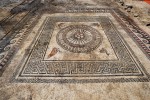 In another part of the site, archaeologists discovered a large colonnaded building which may have begun as a public building and later been converted to a private dwelling. There are four connected rooms, two of them with concrete floors and painted plaster walls, one with a mortar floor embedded with opus signinum tiles. That room leads to the largest, most glamorous of the four: a 645-square-foot space with two large mosaics in the floor.
In another part of the site, archaeologists discovered a large colonnaded building which may have begun as a public building and later been converted to a private dwelling. There are four connected rooms, two of them with concrete floors and painted plaster walls, one with a mortar floor embedded with opus signinum tiles. That room leads to the largest, most glamorous of the four: a 645-square-foot space with two large mosaics in the floor.
 The most spectacular mosaic is bordered with geometric designs — meanders, checkerboards, waves, stripes — surrounding a medallion with rays and chevrons. At the four corners of the medallion are four polychrome animals: a duck, an eagle, a fawn and an owl so enchanting it gives that enameled Roman fibula a run for its money. The second mosaic is much the same size, but its central motif — also geometric borders around a medallion with rays — is much smaller, so there’s a lot more white tile covering the surface area.
The most spectacular mosaic is bordered with geometric designs — meanders, checkerboards, waves, stripes — surrounding a medallion with rays and chevrons. At the four corners of the medallion are four polychrome animals: a duck, an eagle, a fawn and an owl so enchanting it gives that enameled Roman fibula a run for its money. The second mosaic is much the same size, but its central motif — also geometric borders around a medallion with rays — is much smaller, so there’s a lot more white tile covering the surface area.
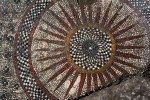 The building was in use until the end of the 1st century A.D. After that, the space was rebuilt several times and the mosaics, damaged over the years, were not repaired. The clean mortar floors were also damaged, but replaced with cheaper, rougher concrete.
The building was in use until the end of the 1st century A.D. After that, the space was rebuilt several times and the mosaics, damaged over the years, were not repaired. The clean mortar floors were also damaged, but replaced with cheaper, rougher concrete.
Other buildings found on the site include a large structure that was probably a 1st century A.D. domus, a large single-family 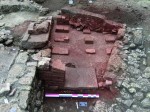 home. Multiple dolia were found in this building, indicating the location was used for wine storage and/or production. There was a mosaic floor found in this dwelling as well, made of individual tesserae in a geometric pattern with dolphins on each of the four corners. This building too was restructured in the late imperial era. A new hypocaust-heated room was built, all of which remains now are the brick piles that allowed the hot air to heat the floor. The building appears to have been in use until the very latest antiquity, through the 7th century.
home. Multiple dolia were found in this building, indicating the location was used for wine storage and/or production. There was a mosaic floor found in this dwelling as well, made of individual tesserae in a geometric pattern with dolphins on each of the four corners. This building too was restructured in the late imperial era. A new hypocaust-heated room was built, all of which remains now are the brick piles that allowed the hot air to heat the floor. The building appears to have been in use until the very latest antiquity, through the 7th century.
 The site will be open to visitors this weekend who will get tours of the finds guided by INRAP experts. This is a one-time deal, I’m afraid, as the current plan is for the mosaics and all the other above-ground elements to be dismantled and raised next month. The dig will continue until the end of the year and the construction of the school is scheduled to be completed in 2019.
The site will be open to visitors this weekend who will get tours of the finds guided by INRAP experts. This is a one-time deal, I’m afraid, as the current plan is for the mosaics and all the other above-ground elements to be dismantled and raised next month. The dig will continue until the end of the year and the construction of the school is scheduled to be completed in 2019.


